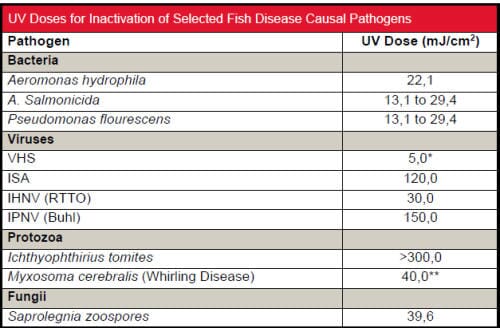Issues in the hatchery
Bio-security concerns: Disease resistance is a growing issue as natural waters become less reliable in terms of microbiological quality.
Increase reliance on recirculating systems: Natural water supply and quality issues are driving increased reliance on recirculation-based facilities – and associated water treatment requirements.
Chemical-free approach: Water treatment solution must not affect water chemistry, thus ruling out chemical-based disinfection.
Greater stock density: Rearing more fish in limited environments results in greater stress and related health implications on fish stock
Regulatory requirements: Reared fish being released to the wild, and those being MSC endorsed require disease-free certifications, increasing the emphasis on water quality and prevention of disease outbreaks.
Bottom line: Lower mortality rates are good for business and increase profitability for growers.
How does ultraviolet (UV) light work?
Giving a brief background to ultraviolet light, Ms Follmer explained that UV light is comprised of electromagnetic radiation of wavelengths ranging from 10 nm to 400 nanometers (nm).
UV-A (Long Wave UV): 315-400 nm
UV-B (Middle Wave UV): 280-315 nm
UV-C (Short Wave UV): 200-280 nm
Vacuum UV: 10-200 nm
UV for disinfection
Ms Follner explained how UV light can be used for disinfection. At the 254 nm wavelength UV light penetrates the cell wall of the microorganism. The amount of UV delivered to the organism is called the intensity.
The UV energy permanently alters the DNA structure of the microorganism in a process called thymine dimerization, Ms Follner said.
This inactivates the microorganism and renders it unable to reproduce or infect.
Advantages of using UV
Ms Follner went on to explain that aquaculture is a fast acting way of disinfecting. "The UV light triggers inactivation within seconds."
Other advantages that Ms Follner went on to explain are that there are no chemical byproducts, UV does not alter water chemistry and its constituents such as pH, taste, odour, colour etc.
She pointed out that UV was a "proven and trusted" method, with it been used to disinfect drinking water and wastewater worldwide.
"Using UV allows producers to focus their time and attention on hatching and rearing fish, as opposed to maintaining equipment," said Ms Follner.
Destroying Ozone
Ozone is often used as a disinfectant in aquaculture facilities, howevr residual ozone must be removed before it comes into contact with fish.
A short UV wavelength of 254 nm consumes residual ozone.
Ozone absorbs the UV energy and quickly dissipates, breaking down in O2 molecules.
Typically, 1.0 ppm of ozone can be removed with a UV dosage of 90 mJ/cm2.
UV dose calculation
UV Dose is the product of UV Light Intensity (quantity of UV light per unit area falling on a surface) and Residence Time (contact time in the reaction chamber).
It is expressed as mJ/cm2 (millijoules/ cm2).
Table 1 shows the doses needed for specific fish diseases found in aquaculture systems.

What affects UV?
UV is affected by a number of different factors including UV transmittance, turbidity, hardess and suspended solids.
These will all reduce intensity.
A fast flow rate, will lower the UV dose, whilst a slow rate will increase it.
Costs
Below are two farms that use Trojan UV, the first for a closed vessel system and the second for a open channel system.
Ocean Farms Hatchery in British Columbia, Canada installed the TrojanUVLogic™ closed vessel system in 2004.
| Closed vessel system for a 680 M3/Hr (3,000 GPM) Hatchery | |
| Peak flow rate | 680 M3/Hr |
| Source water | Spring water supply |
| Water temperature | 40oF (4 oC) |
| UV transmittance | 95 per cent |
| Total suspended solids | <10 mg/L |
| UV dose | >60,000 mJ/cm2 @ end of lamp life |
| Target organism | Gram negative bacteria |
| Duty/ redundant systems | 2 duty/ 2 redundant |
The total capital cost for this system (x TrojanUVLogic 12AL40) was $228,708, with an operation and maintenance cost of $11,242 per year.
The system treata 59,568,000 m3 over a ten year period. Taking into account capital and operation and maintenace costs of $341,128 over the ten year period, the cost per m3 treated is $0.005.
Boot Lagoon Hatchery, in British Columbia, Canada installed the TrojanUV3000™Plus open channel systems with ActiClean™ automatic cleaning in 2002.
| Open vessel system for a 1,1,35 M3/Hr (5,000 GPM) Hatchery | |
| Peak flow rate | 1,135 M3/Hr |
| Source water | Surfacer supply |
| Water temperature | 40oF (4 oC) |
| UV transmittance | 90 per cent |
| Total suspended solids | <10 mg/L |
| UV dose | >60,000 mJ/cm2 @ end of lamp life |
| Target organism | Gram negative bacteria and residual ozone destruction |
For the TrojanUV3000Plus (48 lamps) and installation the cost is $328,400. The operation and maintenance cost per year is $15,456. Over a ten-year period the system treats 99,426,000 m3 of water. With total ten-year capital, operation and maintenance costs amounting to $482,960, the cost per m3 treated is $0.004.
August 2010
